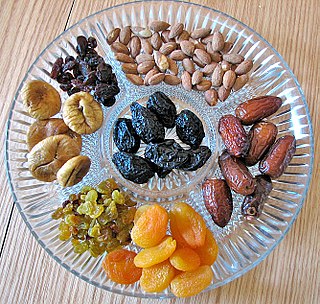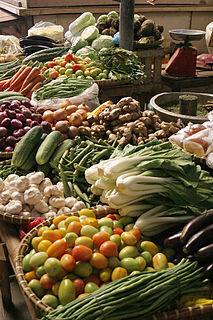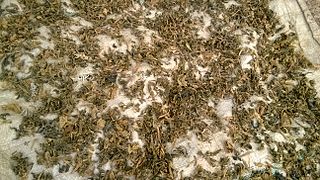
Food is any substance consumed to provide nutritional support for an organism. Food is usually of plant or animal origin, and contains essential nutrients, such as carbohydrates, fats, proteins, vitamins, or minerals. The substance is ingested by an organism and assimilated by the organism's cells to provide energy, maintain life, or stimulate growth.
United States customary units are a system of measurements commonly used in the United States. The United States customary system developed from English units which were in use in the British Empire before the U.S. became an independent country. However, the United Kingdom's system of measures was overhauled in 1824 to create the imperial system, changing the definitions of some units. Therefore, while many U.S. units are essentially similar to their Imperial counterparts, there are significant differences between the systems.

Food storage allows food to be eaten for some time after harvest rather than solely immediately. It is both a traditional domestic skill and, in the form of food logistics, an important industrial and commercial activity. Food preservation, storage, and transport, including timely delivery to consumers, are important to food security, especially for the majority of people throughout the world who rely on others to produce their food. Food is stored by almost every human society and by many animals. Storing of food has several main purposes:

A bushel is an imperial and US customary unit of volume based upon an earlier measure of dry capacity. The old bushel was equal to 2 kennings (obsolete), 4 pecks or 8 dry gallons and was used mostly for agricultural products such as wheat. In modern usage, the volume is nominal, with bushels denoting a mass defined differently for each commodity.

Dried fruit is fruit from which the majority of the original water content has been removed either naturally, through sun drying, or through the use of specialized dryers or dehydrators. Dried fruit has a long tradition of use dating back to the fourth millennium BC in Mesopotamia, and is prized because of its sweet taste, nutritive value, and long shelf life.

A barrel is one of several units of volume applied in various contexts; there are dry barrels, fluid barrels, oil barrels and so forth. For historical reasons the volumes of some barrel units are roughly double the volumes of others; volumes in common usage range approximately from 100 to 200 litres. In many connections the term "drum" is used almost interchangeably with "barrel".

A barrel or cask is a hollow cylindrical container with a bulging center, longer than it is wide. They are traditionally made of wooden staves and bound by wood or metal hoops.

A cooper is a person trained to make wooden casks, barrels, vats, buckets, tubs, troughs and other similar containers from timber staves that were usually heated or steamed to make them pliable.

The Sixty-fourth United States Congress was a meeting of the legislative branch of the United States federal government, composed of the United States Senate and the United States House of Representatives. It met in Washington, DC from March 4, 1915, to March 4, 1917, during the third and fourth years of Woodrow Wilson's presidency. The apportionment of seats in the House of Representatives was based on the Thirteenth Census of the United States in 1910. Both chambers had a Democratic majority.

The Sixty-third United States Congress was a meeting of the legislative branch of the United States federal government, composed of the United States Senate and the United States House of Representatives. It met in Washington, D.C. from March 4, 1913, to March 4, 1915, during the first two years of Woodrow Wilson's presidency. The apportionment of seats in the House of Representatives was based on the Thirteenth Census of the United States in 1910. Both chambers had a Democratic majority.
Dry measures are units of volume to measure bulk commodities that are not fluids and that were typically shipped and sold in standardized containers such as barrels. They have largely been replaced by the units used for measuring liquid volumes in the metric system and the imperial system, though they are still used for some commodities in the US customary system. They were or are typically used in agriculture, agronomy, and commodity markets to measure grain, dried beans, dried and fresh produce, and some seafood. They were formerly used for many other foods, such as salt pork and salted fish, and for industrial commodities such as coal, cement, and lime.

Vegetables are parts of plants that are consumed by humans or other animals as food. The original meaning is still commonly used and is applied to plants collectively to refer to all edible plant matter, including the flowers, fruits, stems, leaves, roots, and seeds. The alternate definition of the term vegetable is applied somewhat arbitrarily, often by culinary and cultural tradition. It may exclude foods derived from some plants that are fruits, flowers, nuts, and cereal grains, but include savoury fruits such as tomatoes and courgettes, flowers such as broccoli, and seeds such as pulses.

Gundruk is a fermented leafy green vegetable and a popular food in Nepal, and it is claimed to be one of the national dishes. It is popular not only in Nepal but also in every Gorkhali or Nepalese diaspora household worldwide. The annual production of gundruk in Nepal is estimated at 2,000 tons and most of the production is carried out at the household level. Gundruk is obtained from the fermentation of leafy vegetables. It is served as a side dish with the main meal and is also used as an appetizer. Gundruk is an important source of minerals, particularly during the off-season when the diet consists of mostly starchy tubers and maize, which tend to be low in minerals.

In United States federal agricultural legislation, the Standard Fruits and Vegetable Baskets and Containers Act of 1916 15 U.S.C. § 251-256 dealt with containers for small fruits and vegetables, and prescribed the exact capacity of the containers.

A grain is a small, hard, dry seed, with or without an attached hull or fruit layer, harvested for human or animal consumption. A grain crop is a grain-producing plant. The two main types of commercial grain crops are cereals and legumes.
The history of USDA nutrition guides includes over 100 years of American nutrition advice. The guides have been updated over time, to adopt new scientific findings and new public health marketing techniques. The current guidelines are the Dietary Guidelines for Americans 2015 - 2020. Over time they have described from 4 to 11 food groups. Various guides have been criticized as not accurately representing scientific information about optimal nutrition, and as being overly influenced by the agricultural industries the USDA promotes.

The Farmers' Market Nutrition Program (FMNP) is a federal assistance program in the United States associated with the Special Supplemental Nutrition Program for Women, Infants and Children that provides fresh, unprepared, locally grown fruits and vegetables and nutrition education to WIC participants. Women, infants and children that have been certified to receive WIC program benefits or who are on a waiting list for WIC certification are eligible to participate in the FMNP.

This is a categorically-organized list of foods. Food is any substance consumed to provide nutritional support for the body. It is usually of plant or animal origin, and contains essential nutrients, such as carbohydrates, fats, proteins, vitamins, or minerals. The substance is ingested by an organism and assimilated by the organism's cells in an effort to produce energy, maintain life, or stimulate growth.

A staple food, food staple, or simply a staple, is a food that is eaten routinely and in such quantities that it constitutes a dominant portion of a standard diet for a given people, supplying a large fraction of energy needs and generally forming a significant proportion of the intake of other nutrients as well. A staple food of a specific society may be eaten as often as every day or every meal, and most people live on a diet based on just a small number of food staples. Specific staples vary from place to place, but typically are inexpensive or readily available foods that supply one or more of the macronutrients needed for survival and health: carbohydrates, proteins, and fats. Typical examples include tubers and roots, grains, legumes, and seeds.














